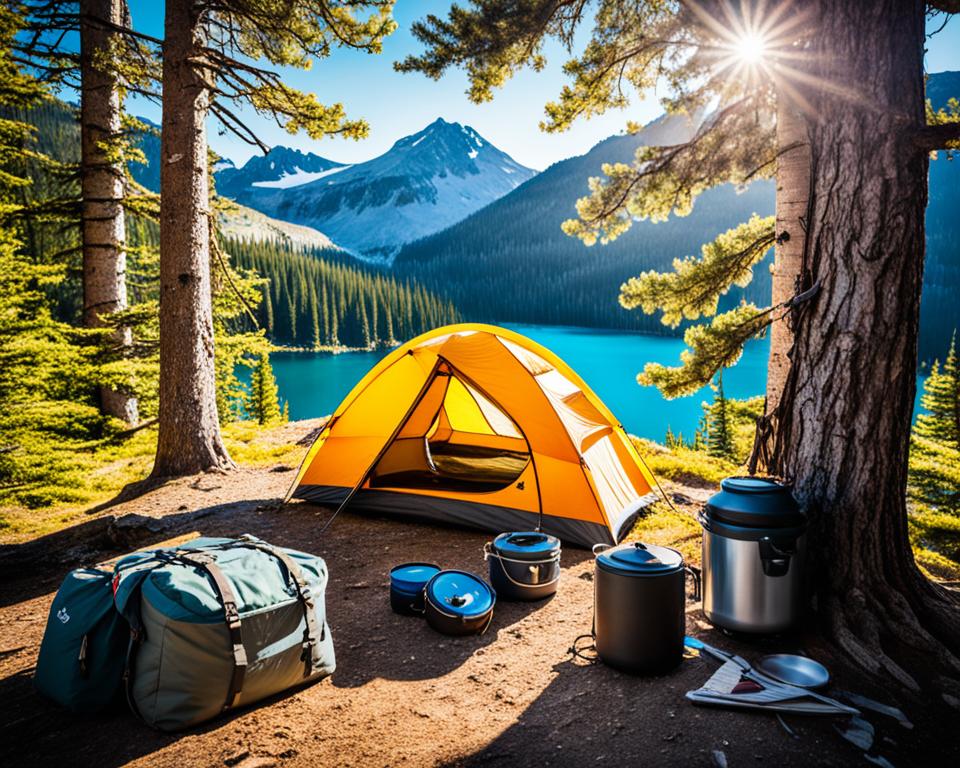Embarking on an outdoor adventure requires more than just a zest for exploration—it demands high-quality, reliable outdoor adventure gear that stands the test of terrains and time. Whether you’re cozying up under the stars in a remote campsite or traversing rugged trails, your experience hinges on camping essentials that promise safety, comfort, and efficiency. Every seasoned wanderer knows the importance of meticulously selected hiking equipment, lightweight backpacking tools, and gear that embodies the spirit of adventure while offering the practicality needed for the great outdoors.
Join us as we guide you through the maze of available outdoor trip products, with tips on identifying the perfect tents for shelter, cook gear for gourmet meals by the fire, and countless other resources that ensure your outdoor expedition is not just manageable, but truly unforgettable.
Key Takeaways
- Invest in outdoor adventure gear that ensures durability, safety, and comfort.
- Camping essentials are the backbone of a successful and enjoyable outdoor experience.
- Well-chosen hiking equipment can enhance performance and safety on the trails.
- The right backpacking tools can make a significant difference in the weight and convenience of your pack.
- Quality tents and cook gear are pivotal for both shelter and nourishment in the wild.
- Being informed and selective with your gear contributes to a more sustainable and environmentally friendly adventure.
Essential Considerations for Outdoor Gear Selection
Embarking on an outdoor adventure requires thoughtful planning and the right gear. When it comes to selecting outdoor equipment, for example at sites like dwights.co.nz, certain criteria should steer your choices towards items that offer gear durability, environmental sustainability, and practicality. Here are key points to keep in mind for an efficient and eco-friendly camping experience.
Durability: Your gear should withstand the elements and the rigors of outdoor use. High-quality materials and construction are vital for long-term functionality and safety.
Eco-Friendliness: Opting for products from companies that are committed to sustainability can significantly reduce your environmental footprint while enjoying the great outdoors.
Weight and Compactness: For activities like hiking and backpacking, the weight and size of your gear are crucial. Lightweight and compact gear make transportation and movement much easier.
Ease-of-Use: Gear that’s intuitive to use can make a world of difference, especially in challenging outdoor conditions where time and convenience are of the essence.
Multi-Functionality: Gear that serves multiple purposes can reduce the quantity of items you need to pack, saving on both weight and space.
Though these criteria provide a solid foundation for outdoor trip planning, personal needs and trip specifics like duration, terrain, and weather also play a central role. To illustrate how these factors converge, here’s a table to guide your decision-making process:
| Criteria | Consideration for Trip Planning | Expert Advice |
|---|---|---|
| Durability | Assess the ruggedness required based on terrain and length of trip. | Invest in quality that withstands frequent use. |
| Eco-Friendliness | Choose brands and products with green manufacturing practices. | Seek gear made from recycled or natural materials. |
| Weight | Balancing load and necessity is key for backpacking. | Consider ultralight options that maintain functionality. |
| Ease-of-Use | Select gear that can be assembled or utilized quickly. | Practice with your gear before the trip to ensure comfort. |
| Multi-Functionality | Identify items that can serve multiple purposes to save space. | Choose innovative gear with added features. |
By integrating these outdoor equipment criteria into your selection process and weighing them against the specifics of your adventure, your preparedness will enhance your overall experience. Remember, informed choices not only contribute to a smoother and safer journey but also help in preserving the delicate balance of nature we all enjoy.
Key Features to Look for in Durable Outdoor Tents
Embarking on an outdoor adventure requires a reliable shelter. The perfect tent not only offers comfort but also braves the elements, ensuring your camping experience is exceptional. To guide your purchase of the ultimate outdoor abode, we’re diving deep into the essentials of all-season tents, the science behind tent materials, and the aspects that contribute to the ease of tent setup.
Weather Resistance and Seasonality
When confronting the unpredictability of nature, your shelter should be steadfast. An all-season tent implies readiness for anything from summer showers to wintry blasts. Seek tents with a high hydrostatic rating for water resistance, sturdy poles to combat gusts, and a design focused on maintaining an equitable internal environment regardless of external conditions.
Space and Capacity Requirements
Space is a luxury in the wilderness. Family camping tents prioritize roominess to accommodate groups and gear. Look for a tent that balances spatial generosity with structural integrity, offering enough room to move comfortably without compromising on safety and warmth.
Material and Pole Construction
The savviness of tent material science is evident in modern shelters. Advanced fabrics offer longevity, waterproofing, and ultraviolet protection. Poles, the skeleton of your tent, should be resilient yet lightweight—aluminum and fiberglass are popular contenders. This combination is vital for tent setup ease and overall dependability.
| Tent Model | Seasonality | Capacity | Water Resistance | Material | Pole Type | Setup Ease |
|---|---|---|---|---|---|---|
| Alpha Camp Dome Tent | All-Season | 6-person | 3000mm | Polyester | Aluminum | Color-coded assembly |
| Big Agnes Flying Diamond | 4-Season | 8-person | 1500mm | Nylon | Aluminum | Quick Stash |
| REI Co-op Kingdom Tent | 3-Season | 6-person | 1200mm | Polyester | Aluminum | Hubbed pole assembly |
| MSR Hubba Hubba NX | 3-Season | 2-person | 3000mm | Ripstop Nylon | Aluminum | Unified system |
Cook Gear Must-Haves for Outdoor Enthusiasts
Embracing the serenity of the great outdoors invariably involves the savory experience of outdoor meal prep. Whether you’re a backcountry gourmet or a fan of simple campfire staples, having the right camping stoves, portable grills, and campfire cookware is essential for any outdoor excursion. Let’s delve into the kitchen essentials that make wilderness cuisine both possible and delightful.
Portable, efficient, and designed for the ruggedness of outdoor life, camping stoves come in various forms to suit your culinary style. From ultralight backpacking models to larger, robust units for group cooking, the versatility of these stoves has revolutionized campsite dining. Portable grills, on the other hand, offer that chargrilled flavor that’s synonymous with outdoor dining. Compact and easy to assemble, these grills are perfect for grilling everything from fresh fish to hearty steaks.
No camp kitchen is complete without durable campfire cookware. Cast iron skillets, pots, and Dutch ovens can withstand the heat of the flames and allow for a variety of cooking techniques from searing to slow-cooking stews. Now, consider the benefits of pre-planning your meals: it not only saves time but also ensures that you can pack efficiently and reduce waste, all while maintaining a minimal environmental footprint at your campsite.
- Meal Planning: Preparing and packing meal ingredients ahead of time reduces waste and saves fuel.
- Multi-Use Utensils: Opt for tools that can perform multiple functions to lighten your pack and simplify cooking.
- Eco-friendly Practices: Make use of biodegradable soaps and properly dispose of waste to maintain the integrity of the outdoors.
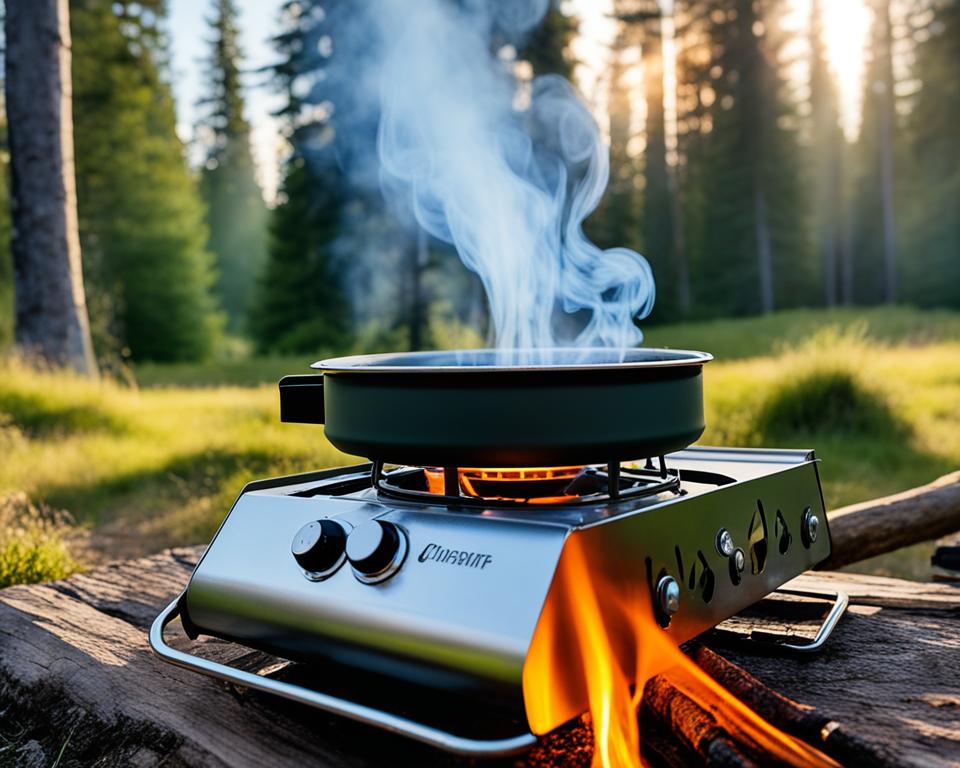
As you choose your camp kitchen gear, remember to consider size, weight, and fuel efficiency — paramount qualities for both the casual camper and the serious trekker. When planning your meals, think about the energy you’ll need for your adventures, as well as how you can indulge in your favorite foods away from the convenience of your home kitchen.
| Cook Gear | Type | Key Feature | Why It’s a Must-Have |
|---|---|---|---|
| Camping Stove | Backpacking / Group | Lightweight / Robust | Essential for boiling water and cooking meals in any location. |
| Portable Grill | Charcoal / Propane | Compact / Easy to use | Provides the pleasure of grilling foods with the added bonus of portability. |
| Cast Iron Skillet | Cookware | Durable / Non-stick | Perfect for a variety of campfire meals and can last a lifetime. |
| Dutch Oven | Cookware | Versatile / Heavy-duty | Exceptional for slow-cooking stews and even baking bread at the campsite. |
Dive into the joy of campfire cookware, the convenience of camping stoves, and the ambiance that portable grills bring to your outdoor dining. The right gear not only facilitates mouth-watering meals but also becomes an integral part of the memories you make while exploring the great outdoors.
Choosing the Right Sleeping Bags and Pads
As the stars twinkle above and the campfire dims, a good night’s sleep in the great outdoors can invigorate the soul. But the key to sleeping under the open sky comfortably lies in the selection of a proper sleep system for camping. This means understanding the interplay between the ruggedness of all-weather sleeping bags, the support of the right sleeping pad, and the technical specifications of insulation materials.
https://www.youtube.com/watch?v=MLyfFLQ4vbM
Understanding Temperature Ratings
Temperature ratings on sleeping bags serve as a guideline for the lowest temperature at which the average sleeper should remain comfortable. These ratings are crucial, especially when choosing all-weather sleeping bags, as they indicate the range of conditions the bag is designed for, from summer nights to the frosty embrace of winter.
Inflatable vs Foam Pads: Pros and Cons
When considering sleeping pad selection, inflatable and foam pads stand out as popular options, each with their benefits. Inflatable pads offer superior comfort and compactness but require a bit more effort to set up. Foam pads, on the other hand, provide reliable insulation and quick deployment but can be bulkier and less forgiving to rocky terrain.
The Importance of Insulation Types
The heart of a sleeping bag’s warmth lies in its insulation materials. Down, favored for its excellent warmth-to-weight ratio, is ideal for those who prioritize packability and warmth in cold, dry conditions. Synthetic insulation, while heavier, excels in damp climates thanks to its ability to retain heat even when wet.
| Features | Inflatable Pads | Foam Pads | All-Weather Sleeping Bags |
|---|---|---|---|
| Comfort | High (adjustable firmness) | Low to moderate | Varies with fill material |
| Packability | Compact when deflated | Bulkier | Highly packable with down insulation |
| Warmth | Depends on R-value* | Consistent R-value | Temperature rating specific |
| Weight | Light to moderate | Light | Varies; down is lighter |
| Durability | Vulnerable to punctures | Highly durable | Depends on shell material |
| Climate Suitability | Good for Cold and temperate | Generally good for temperate | Excellent with correct temperature rating |
*R-value indicates the sleeping pad’s capacity to resist heat flow; the higher the R-value, the warmer the pad.
Arming yourself with this knowledge will ensure you wake up refreshed and ready to embrace the day’s adventures. The right combination of a snug sleeping bag and a supportive pad can transform any spot of earth into a five-star retreat—as close to nature as it gets.
Navigating Outdoor Footwear: From Hiking Boots to Water Shoes
Embarking on any outdoor adventure requires reliable footwear that can handle the environment and provide comfort throughout the journey. The type of terrain, expected weather conditions, and individual needs of each adventurer will determine whether waterproof hiking boots, ergonomic trail shoes, or quick-drying water shoes are the best fit for an expedition. This section explores the factors to consider when selecting the perfect pair, ensuring their longevity through proper footwear maintenance, and ultimately safeguarding your outdoor experiences.
The Importance of Material and Tread Design
Material selection is crucial for durability and performance in outdoor footwear. Boots and shoes designed for hiking need to repel water, resist abrasion, and breathe to wick moisture away from the foot. Ergonomic features like cushioned insoles and supportive arches are also key. Tread designs vary significantly; deeper lugs are ideal for muddy and rugged terrain, while a closer lug pattern may suffice for well-maintained trails. The right combination of these features can prevent slips and falls, contributing to a safer and more enjoyable outing.
Finding the Perfect Fit for All-Day Comfort
Ergonomics is not just about the footwear structure; the fit is equally fundamental to ensure all-day comfort and prevent foot fatigue. Experts suggest trying on boots and trail shoes later in the day when feet are more likely to be swollen to their maximum size, mimicking their state during a long hike. It’s essential to wear the same socks that you would during the actual outdoor activities and to walk around in the footwear for a significant period before deciding on the best fit.
Caring for Your Outdoor Footwear
To extend the life of your footwear, regular maintenance is key. This involves cleaning off dirt and debris after each use, allowing them to dry naturally away from direct heat sources, and treating leather components with appropriate conditioners. For waterproof hiking boots, reapplying a water-resistant treatment periodically can keep them performing at their best. Proper care and storage will not only prolong the lifespan of your footwear but also ensure they are ready to go when the next adventure calls.
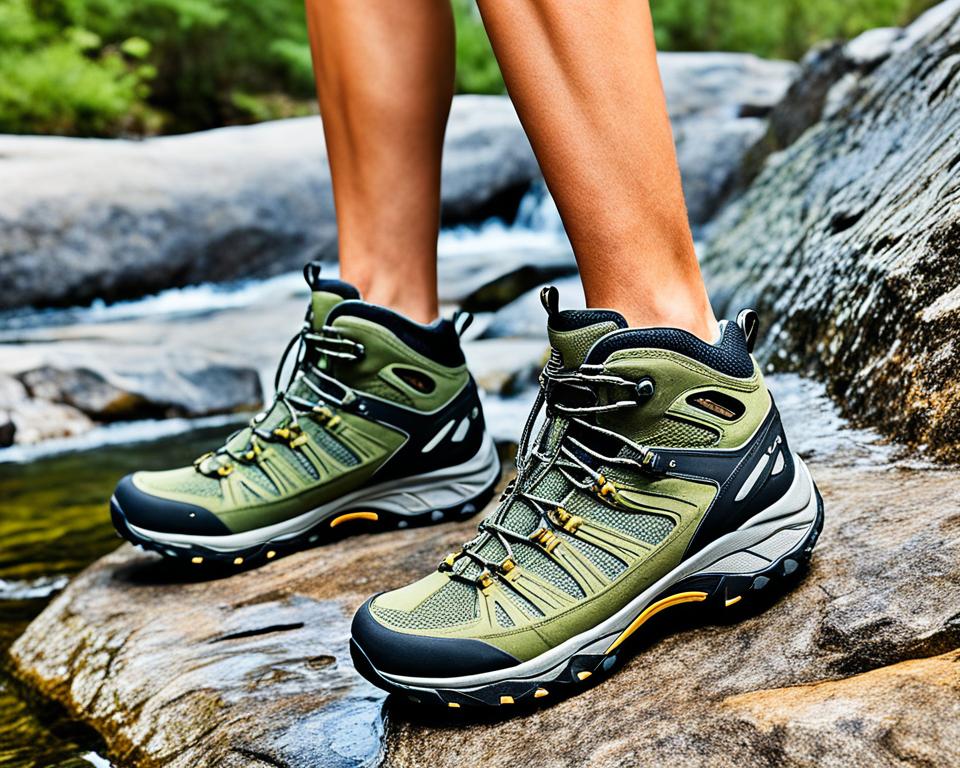
- Always break in new footwear before embarking on long outdoor trips.
- Replace worn laces to prevent tripping or discomfort.
- Consider specialty insoles for additional arch or heel support.
- Inspect footwear before and after trips for any damage or wear.
- Keep multiple pairs to rotate usage, reducing wear on any single pair.
- Store footwear in a cool, dry place to prevent material decay.
| Footwear Type | Pros | Cons | Best Use |
|---|---|---|---|
| Waterproof Hiking Boots | Durable, High ankle support | Can be heavy and warm | Rugged terrain, wet conditions |
| Trail Shoes | Lightweight, good traction | Less ankle support | Day hikes, well-maintained trails |
| Water Shoes | Quick drying, breathable | Minimal protection | Water activities, casual wear |
Choosing the right outdoor footwear involves careful consideration of material and design, prioritizing fit for comfort, and committing to regular maintenance. With these guidelines, adventurers can ensure they have the best possible experience on their outdoor journeys.
Packing Smart: A Guide to Efficient Outdoor Gear Storage
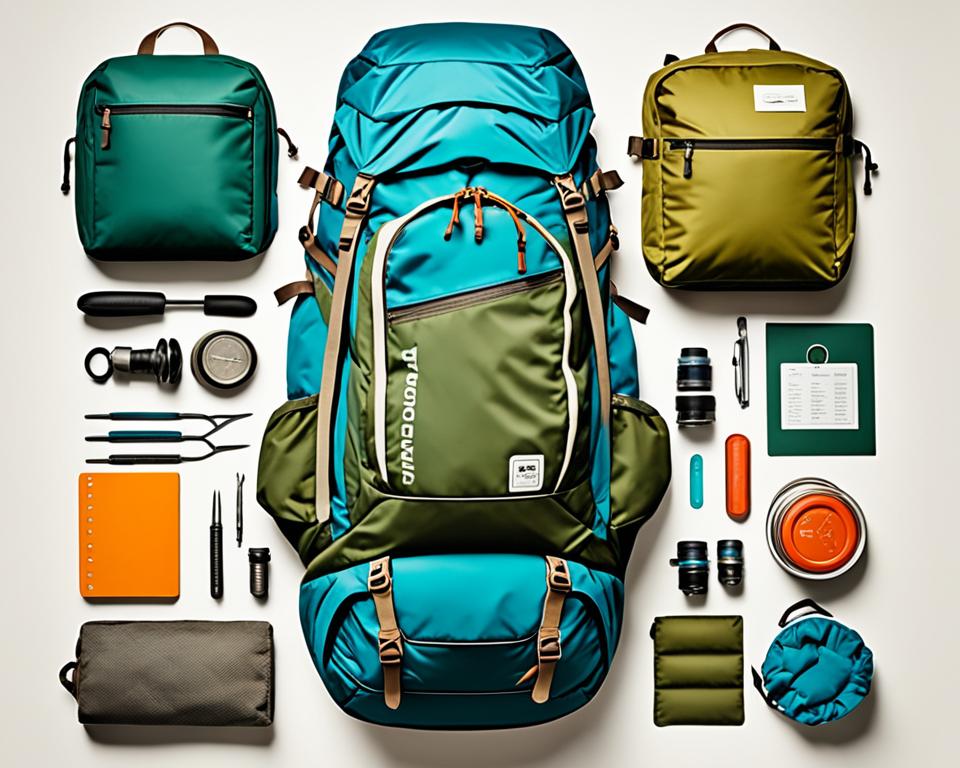
Mastering the art of backpack organization is fundamental for any outdoor enthusiast. Achieving lightweight packing doesn’t just alleviate physical strain; it allows for a more immersive and enjoyable outdoor experience. When selecting your gear, remember to prioritize multi-use gear to streamline your load and ensure you’re not weighed down by unnecessary items. To bolster your prep routine, we’ve constructed a comprehensive camping packing checklist tailored for efficiency and convenience.
| Category | Item | Use | Notes |
|---|---|---|---|
| Sleep System | Inflatable Sleeping Pad | Sleeping Comfort | Double as a seating pad |
| Cookware | Compact Multi-fuel Stove | Cooking and Boiling Water | Works with various fuel types |
| Clothing | Convertible Pants | Protection and Versatility | Zip-off legs transform into shorts |
| Wearables | Multi-functional Watch | Time, Compass, Altimeter | Eliminates the need for separate devices |
| Hydration | Water Filter Bottle | Drinking Water Purification | No need for carrying excess water |
| Utility | Multi-tool | Various Handy Tools | Replaces a whole toolkit |
Every traveler’s needs are different, hence this checklist should serve as a baseline to adapt from. The overarching philosophy is to keep everything compact and as light as possible. Integrating such multi-use gear into your pack ensures you’re prepared for all scenarios without overburdening your shoulders.
- Prioritize items that serve multiple purposes to save space and weight.
- Roll or bundle clothes to minimize volume and prevent creasing.
- Utilize the space inside your cooking pot to store small items like spices or a mini stove.
- Maximize the usefulness of every item—e.g., a bandana can serve as a neck gaiter, towel, or pot holder.
- Regularly review and update your checklist to discard redundant items and incorporate new multi-functional gear.
By adhering to these backpack organization techniques and customized camping packing checklist essentials, you’ll refine your outdoor gear storage to be efficient and functional, making sure you can cover miles with ease and bring only what truly matters.
Finding the Best Products for Your Outdoor Trip (Tents, Cooking Equipment, etc.)
Embarking on an outdoor adventure requires not only a spirit of exploration but also the right gear to ensure a safe and enjoyable experience. Our guide offers thorough insights into top-quality outdoor products, with valuable tips on where to secure the best deals. Whether you are a seasoned camper looking for an upgrade or a novice setting out for your first trip, comprehending the variances among brands and equipment is crucial.
Comparing Top Tent Brands
Brand comparison is vital when choosing a tent for your outdoor adventures. Below, we’ve compiled expert gear reviews of top tent brands to help you navigate through the myriad of options. Factors to consider include durability, weather resistance, weight, and user-friendliness. Here are some of the industry leaders renowned for their high-quality camping cookware and tents:
| Brand | Weather Resistance | Weight | Durability | Price Range |
|---|---|---|---|---|
| REI Co-op | High | Light to Medium | Strong | $$-$$$ |
| MSR | Very High | Light | Very Strong | $$$ |
| Big Agnes | High | Light | Strong | $$$ |
| Coleman | Moderate | Medium to Heavy | Moderate | $-$$ |
| NEMO | High | Light | Strong | $$$ |
Essential Cooking Equipment for Every Trip
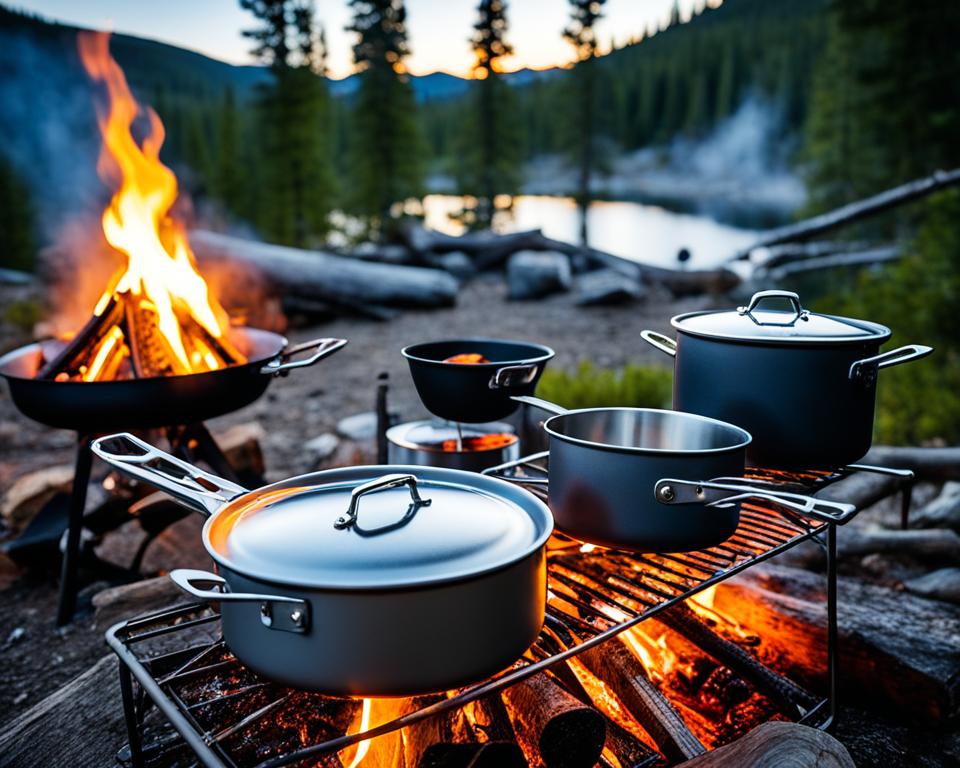
What’s an adventure without the taste of outdoors-cooked meals? We recommend looking for high-quality camping cookware that provides the perfect balance between functionality and portability. Whether it’s a lightweight stove, a durable pot, or a versatile utensil set, having the right cooking gear can enhance your outdoor culinary experience significantly. Some reputed brands known for their excellence include Jetboil for stoves, GSI Outdoors for cookware, and Sea to Summit for utensils and accessories.
Where to Find the Best Deals on Outdoor Gear
In the quest for value, outdoor gear discounts can often be found, if you know where to look. Seasonal sales at major retailers like REI or Backcountry are a great starting point. For the budget-conscious, platforms such as Steep & Cheap offer daily deals on premium brands. It’s also worth checking out local outdoor gear swaps or online marketplaces for second-hand gear. Just remember, quality should never be compromised for the sake of savings.
Must-Have Accessories for an Outdoor Adventure
Embarking on an outdoor adventure requires more than just a spirit of exploration; it necessitates careful preparation in the form of reliable survival accessories. To maintain safety and efficiency in the wild, one must invest in quality hydration strategies, renewable energy devices, and an accurate wilderness GPS system. These not only ensure a secure journey but also contribute to a more enjoyable and sustainable experience in nature.
Water Filtration Systems
Access to clean drinking water is imperative when venturing into the great outdoors. Advanced water filtration systems are an essential component of modern hydration strategies, enabling adventurers to convert water from natural sources into potable water. Here are reviews of different products focused on capacity, filter lifespan, and ease of use.
| Brand | Model | Capacity | Filter Lifespan | Portability |
|---|---|---|---|---|
| Sawyer | MINI Filter | 100,000 Gallons | Lifetime Warranty | Ultra-Compact |
| LifeStraw | Personal Water Filter | 1,000 Gallons | 5 Years | Lightweight |
| Katadyn | Hiker Pro Transparent | Up to 300 Gallons | Replaceable | Handheld |
Portable Power Solutions
Renewable energy devices have seen a dramatic rise in popularity among outdoor enthusiasts. Portable solar panels and solar generators provide a sustainable means to keep electronic devices charged without relying on traditional power sources. These devices are particularly beneficial for longer trips where access to power is limited.
Navigation Tools for the Wild
Navigating the wilderness can be daunting without the right tools. A quality wilderness GPS can prove to be the difference between a successful trek and a distressing ordeal. Modern GPS devices offer an array of features such as topographical maps, waypoints, and even SOS functions to ensure a safe and well-guided adventure.
- Garmin GPSMAP 64st: High-sensitivity GPS with GLONASS receiver.
- Suunto Traverse Alpha: Combines a strong build with a full set of outdoor features.
- Magellan eXplorist 310: Affordable yet robust with essential navigation functions.
Conclusion
As we journey through the final steps of this ultimate camping guide, it’s essential to reflect on the crux of outdoor adventure preparation. From the robust all-weather tents to the portable cooking gear, each item has been meticulously covered to ensure your adventures are not just enjoyable, but truly unforgettable. Remember, an essential camping checklist is your roadmap to a seamless experience—marking items off as you pack promises a level of readiness that only the well-informed and cautious adventurers possess.
Crafting an unforgettable backpacking experience is not just about the gear, it’s about the memories you create and the connection you forge with nature. With this guide, you’re now equipped with the knowledge to select top-grade equipment that stands the test of time and elements. The outdoor realm awaits your explorative spirit, and with these tools at your disposal, each trip promises to be an extraordinary chapter in your book of adventures.
Whether scaling craggy peaks or lounging by serene lakes, the right preparation can turn the great outdoors into a home away from home. Take these lessons, tips, and product insights with you as you venture forth. Safe travels and may your outdoor experiences be nothing short of spectacular, as you seek to explore, enjoy, and embrace the wonders that lie beyond the beaten path.
FAQ
What are the most important qualities to look for in outdoor adventure gear?
When you’re selecting outdoor adventure gear, key qualities to focus on include durability, weight, ease-of-use, and multi-functionality. It’s also essential to consider the gear’s suitability for your specific outdoor activities, whether it’s hiking, backpacking, or camping.
How do I choose a tent that’s right for my camping needs?
Selecting the right tent involves considering weather resistance, capacity, and construction materials. Look for all-season tents if you camp in various conditions, ensure the tent has enough space for all occupants, and that it’s made from materials that can withstand the rigors of your outdoor activities.
What should be included in my outdoor trip planning, particularly with gear selection?
For outdoor trip planning, prioritize gear based on the trip duration, terrain, and weather conditions you expect to encounter. Always consider the environmental impact, and select eco-friendly camping options whenever possible. Also, take into account your personal needs for comfort and safety.
What are some cook gear essentials for outdoor enthusiasts?
Essential cook gear includes a portable camping stove or grill, durable campfire cookware, and utensils suitable for outdoor cooking. Don’t forget about pre-planning your meals, ensuring safe food storage, and maintaining minimal environmental impact while preparing food.
How do I select the right sleeping bag and pad for camping in different climates?
Look at the temperature ratings of sleeping bags to match them with the weather conditions you expect. Compare the pros and cons of inflatable versus foam pads according to your comfort preferences. Additionally, consider the insulation material like down or synthetic, especially if you plan on camping in a range of temperatures.
When choosing hiking boots, what features should I consider?
For hiking boots, focus on material durability, tread design suited to your hiking terrain, and ergonomics for comfort. Ensure the boots fit well to prevent blisters or discomfort, and learn how to care for them to extend their lifespan.
What are some tips for efficiently packing outdoor gear?
Efficient packing involves organizing your backpack for easy access, maximizing space using smart packing techniques, and minimizing weight. Consider multi-use gear that fulfills more than one purpose, and use a camping packing checklist to ensure you don’t leave any essentials behind.
How can I find high-quality camping cookware without breaking the bank?
You can find high-quality camping cookware by comparing brands, reading expert gear reviews, looking for outdoor gear discounts, shopping in-season sales, or considering second-hand items that are still in good condition.
What are some must-have accessories for an outdoor adventure?
Must-have accessories for an outdoor adventure include a reliable water filtration system, portable power solutions such as solar chargers, and navigation tools like a wilderness GPS or a traditional compass and map. These accessories can significantly enhance safety and convenience.

